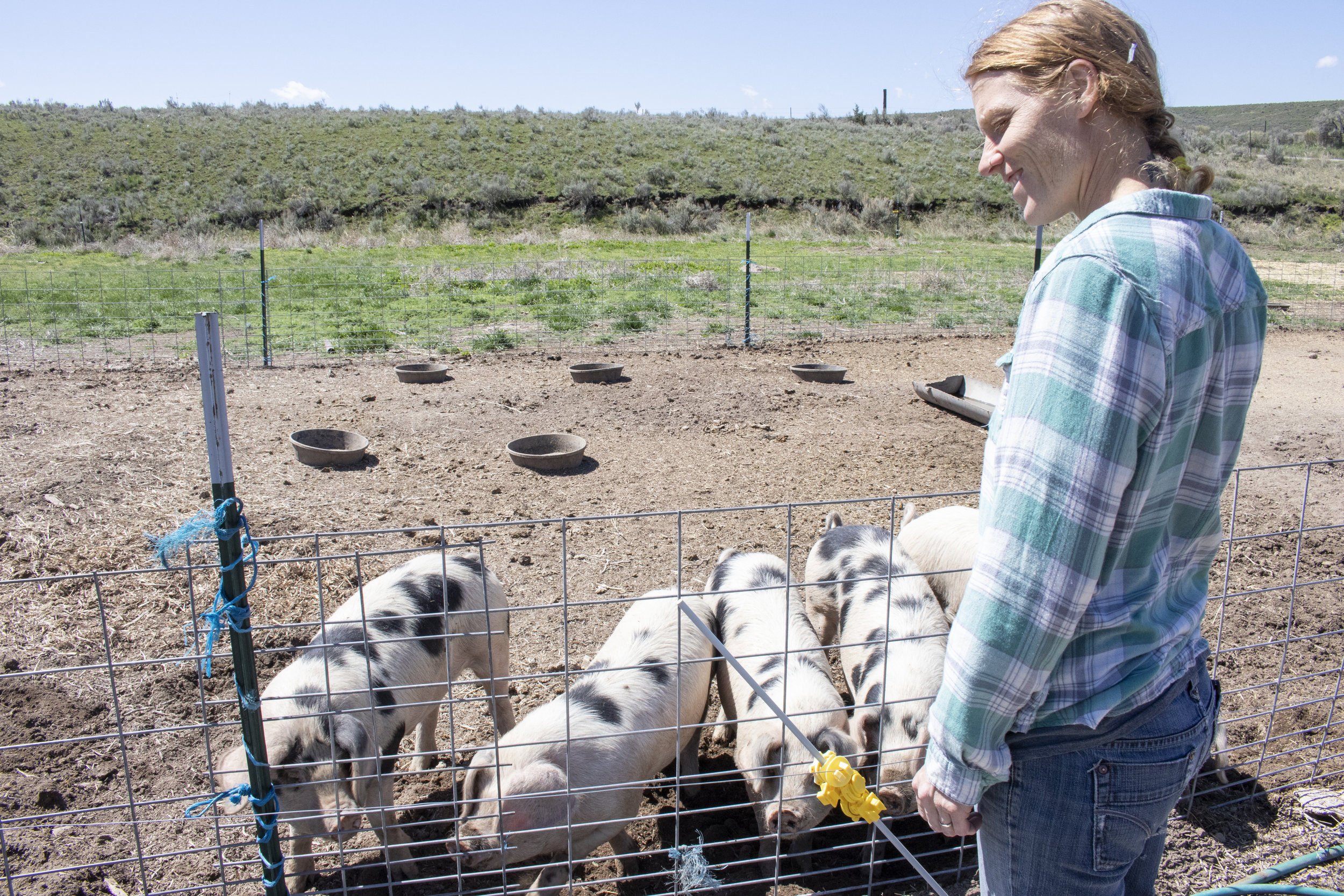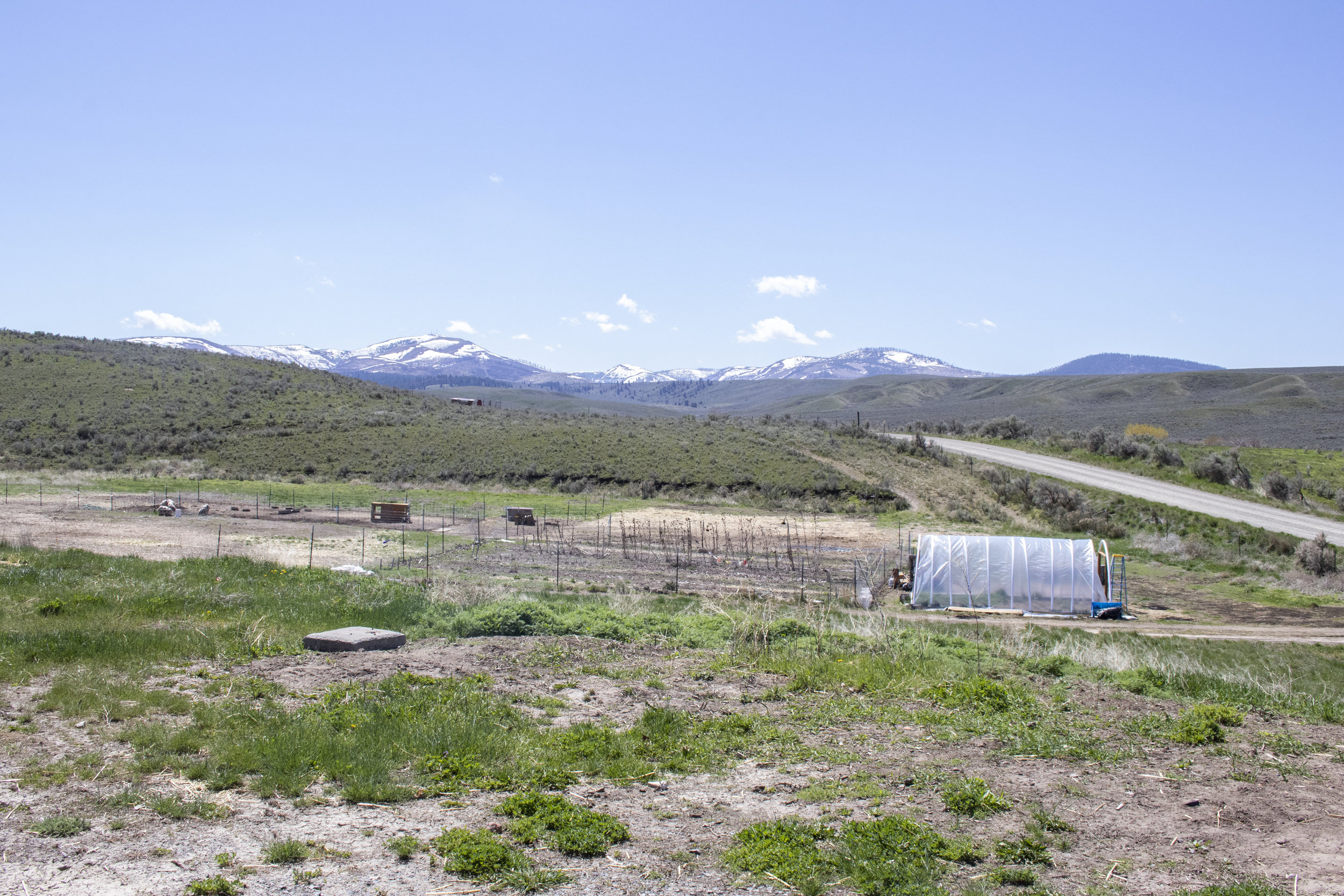Young Roots Farm: Mindful Food for Mindful People
Farmer Amy Young at Young Roots Farm in Baker City, Oregon. Young Roots Farm is a small, ever-diversifying, woman-owned and operated farm raising food mindfully for family and community.
In the hills above Sutton Creek, southeast of Baker City, Oregon, a group of Gloucestershire Old Spot pigs trot over sagebrush and bunchgrass filled pastures towards farmer Amy Young. She stands on a paddock smiling and ready to greet them.
“My pigs are the happiest pigs you’ll ever come across,” Amy says, scratching one of the pigs behind the ears. “They spend their entire lives outside, rooting around being pigs. They are never confined or on concrete and they are never fed any genetically modified organism, corn, or soy.”
Amy’s farm is in stark contrast to the way over 80 percent of pigs in the U.S. are raised.
Amy Young owns and operates Young Roots Farm, a small, woman-owned, ever-diversifying farm. Amy is focused on nourishing the community while regenerating the land. Her decision to produce pasture-raised pork culminated for two reasons. First, Amy saw a need for locally raised, pasture pork in her community. She says there was plentiful access to local beef but no good options for local pork. Young Roots Farm products are sold near Baker City, Oregon, at Baker Food Co-Op, Bella Main Street Market, Summer at the Starbottle Saloon, and on the farm. The dollars spent on Young Roots products go right back into the local economy, as Amy tries to purchase everything the farm and her family needs within the community. Amy’s second reason for choosing to raise pork: She was intrigued by the ways in which pigs can aid regenerative agriculture.
“People have to have food if they want to survive and how that food is grown determines whether or not the planet is going to survive,” Amy says.
Since starting Young Roots Farm six years ago, Amy has committed her farm to improving the land through regenerative agriculture. Regenerative agriculture is a reclamation approach to food and farming focused on soil health. Amy is working on building healthy land through utilizing rotational grazing techniques and monitoring soil health. She is dedicated to continuing her education on regenerative agriculture and is constantly researching new ways to improve the land.
Amy Young stands with her Gloucestershire Old Spot pigs
“My number one priority is building the soil,” Amy says.
Amy utilizes biodynamics in her practice, a holistic and ecological approach to farming that recognizes the entire operation as a living system. By recognizing the whole farm ecosystem, Amy helps it evolve in a way that builds healthy soils, which are the base of a nourishing food system.
Amy longs for a “steward” relationship between farmers and the land. To Amy, stewardship fosters healthy land, sustainability and a healthy end product. She wants consumers to demand that of their farmers and producers.
Amy grew up in southern Idaho on a conventional grain farm and cattle ranch. Although she didn’t come across the methodologies of regenerative agriculture until a few years ago, she has always felt a pull towards animal agriculture.
“There’s that old adage, you can take the girl off the farm but you can’t take the farmer out of the girl,” Amy says.
Amy studied animal sciences in undergrad at Oregon State University but had a change of heart when she realized her animal production classes solely focused on feedlots.
“I was sitting in that class and I thought ‘ah, hell no.’”
Over the years, the independence of public land grant universities has been up for debate as some of their biggest funders are industrial agriculture. Amy didn’t see herself fitting into the model being offered, so she pursued her other passion, the environment.
“I've always had that nature bent and environmental bent,” Amy says.
Before starting Young Roots Farm, Amy spent time doing salmon restoration work near Portland. It was there her passion and drive for environmentalism and animals solidified.
“I think about mother earth all the time,” Amy says, “I used to get so anxious and upset because all I wanted to do was save the planet.”
Amy says she finally came to the realization that she couldn’t do all of the things she wanted to do to save the planet. As she came to grasp that, she saw a clear way to help mitigate the problem.
“Agriculture contributes to so much pollution and to so much of the climate crisis,” Amy says, “by practicing agriculture in a way that actually is good for the environment, I’m hoping to inspire and influence others to do the same.”
By sharing her story, Amy wants other producers to consider regenerative farming methods and she wants consumers to be conscious about where they purchase food. She says together, we can change the agricultural and food system. Consumers have a choice, whether they want to support local producers and farmers, the environment, healthy products—or not. There’s a huge opportunity for producers and consumers to support their health, the environment and their economy. That connection should be at the forefront of our values, Amy says.
Young Roots Farm in Baker City, Oregon.
Amy’s values and practice are somewhat rare in the hog producing industry these days.
Over the last three decades, animal agriculture has changed drastically. The number of independent producers plummeted thanks to contract farming, vertical integration, corporate retaliation, and unfair markets.
In the 1978 Agriculture Census, there were 512,292 hog farms in the United States that reported an average inventory of 115 animals each. Only three percent of hog farms had inventories of 5,000 head or more. The 2012 Agriculture Census reported only 63,246 farms with hogs, an 87 percent decline in less than 35 years. The average 2012 hog farm had 1,043 animals in inventory, with 83 percent of animals in operations with more than 5,000 head. The eradication of small family hog farmers started in the late 80s and early 90s when Concentrated Animal Feeding Operations (CAFOs) or factory farms were introduced to increase productivity. Through contract farming, many larger companies bought family farms or merged with them by providing pigs in exchange for land and waste management services. As the hog industry moved towards the corporate production model – one already in place for the poultry industry – thousands of independent farmers were pushed out of the business. In North Carolina alone, one of the top producing hog states, the number of hog farmers in the state fell from more than 11,000 in 1982 to 2,217 in 2012 -- while the number of hogs grew significantly.
Today, four pork packers slaughter 57 percent of hogs in the United States. The consolidation of the market reduces competition and hurts family farmers ability to get a fair price for their pork. This system of hog production is designed to decrease the number of farmers while increasing the number of hogs. This hurts rural communities and this trend of factory farm hog production is disturbing local economies, the environment, and the quality of pork. In most cases, the people making the major decisions about the hog operation do not live in the community where the hogs are raised. The outcome of these structural changes have resulted in a significant loss of family farmers, less competition in the marketplace, and pressure to conform to contract, large scale production.
When marketing her products, Amy looks at conventional prices at the store and measures all the care she has put into her product as well as the costs she pays of butchering the animal and packaging, and then compares it to what consumers are likely to pay. She says it’s this delicate balance of wanting a good price for her work and being realistic about what consumers are capable of paying. Corporate control of the markets through vertical integration drives down the price of conventional pork for the consumer, forcing Amy to explain and educate on why her product is different than the rest. Despite the uphill battle, Amy is actively building awareness and educating her community through her innovative practices. She sees her product standing out in the community. The feedback and communication she has with her customers reaffirms she’s doing things right.


